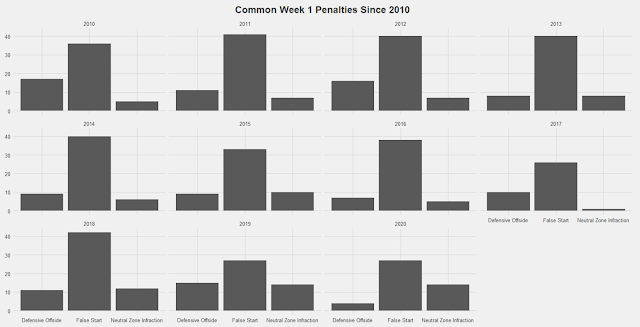I compared the total number of penalties that I subjectively thought of as indicative of crisp play for every week one since the 2010 season. Before I dig into those, I first aggregated the total number of penalties in each season during week one.
Week one this season had the lowest number of penalties since 2010. Given my prior, I was shocked. The narrative that teams would not be as sharp, at least in regards to penalties, does not hold up to scrutiny. As I alluded to above, I broke it down my penalty type to see if I could find any aberrations in the data from this season.
False starts by the offense in 2020 was on the low end of outcomes in the sample, similar to the levels in 2010. Defensive offside was way down, but neutral zone infractions were at an all-time high, tied with the number in 2019 (14 total penalties). Given the small sample of neutral zone infractions in a given week, I was not sure whether I should chalk this phenomenon up to defenders being lackadaisical when lining up pre-snap or just random variation. If you were being more aggressive in parsing the data or more attached to your prior, I am sure you would subscribe to the former idea. Given the fact that there was literally no change from 2019, however, and I would say this is noise.Delay of game penalties are a function of either the quarterback and play-caller not being on the same page, players not knowing where to line up, or just inattentiveness by the quarterback with regards to the play clock. We saw the most delay of game penalties since the 2012 season, another possible indicator of teams suffering from a lack of practice. Still, there was only one more delay of game penalty compared to 2019 and only two more than the 2015 and 2016 seasons. One delay of game penalty across 16 games is only 0.06 more penalties per game. Again, nothing here.
Holding penalties were way down compared to prior seasons. The degree to which they were down makes me think that the referees were making an effort to call less of these in the 2020. This is something I will keep my eye on as the season progresses. Still, using holding penalties as evidence of sloppy plays is without merits.
Roughing the passer penalties are a good gauge of how disciplined pass-rushers are when attacking opposing quarterbacks. After a spike in 2018 when the NFL changed what constituted a roughing the passer penalty, this type of penalty was called at a similar level to 2019 and seasons prior to 2018. Given the set of rules, it seems defenders were just as disciplined as they would be with more practice and preseason games.
After looking at all these penalties, the idea that the unusual off-season schedule would affect the quality of play is not true when you dig into the data. Using penalties as a proxy for sloppiness is not the only way to evaluate the play in week one. We can look at offensive performance, special team performance, or turnovers to find any reason to think that the play was objectively worse this year than in prior years. EPA per play was actually higher in 2020 than in 2019 (0.0466 in 2020 versus 0.0459 in 2019). 71.6 percent of all field goals were made, compared to the previous rates of 84.2, 82.5, 88.1, and 82.1 percent in the prior four seasons. Overall, the rate in 2020 was the lowest since 2010 so if you want to use that as justification that preseason or extra practices were missed I guess that is warranted. But when we are enjoying football on Sundays, we care more about how the offenses perform. In 2020, there were 34 total fumbles and 20 total interceptions. These were both the lowest totals since 2016. So, pointing to turnovers is not grounds for disparaging the quality of play. With all of this being said, I think we can conclude that we saw characteristically great football in week one even without normal camps and preseason. Going forward, this may provide evidence that we do not need the preseason nor the extensive practice schedules characteristic of NFL teams. Coaches may hate this, but I am sure the players would welcome the rest. It will be interesting to see what this means in the future. Given the success of week one, I wonder if the league will dangle less preseason games and practices to get concessions from the players side in the next round of CBA negotiations with the knowledge that losing the preseason and some practices will not hurt the product on the field. The CBA expires after this season, so starting in March, keep an eye on this as the two sides negotiate and battle through the media.





No comments:
Post a Comment